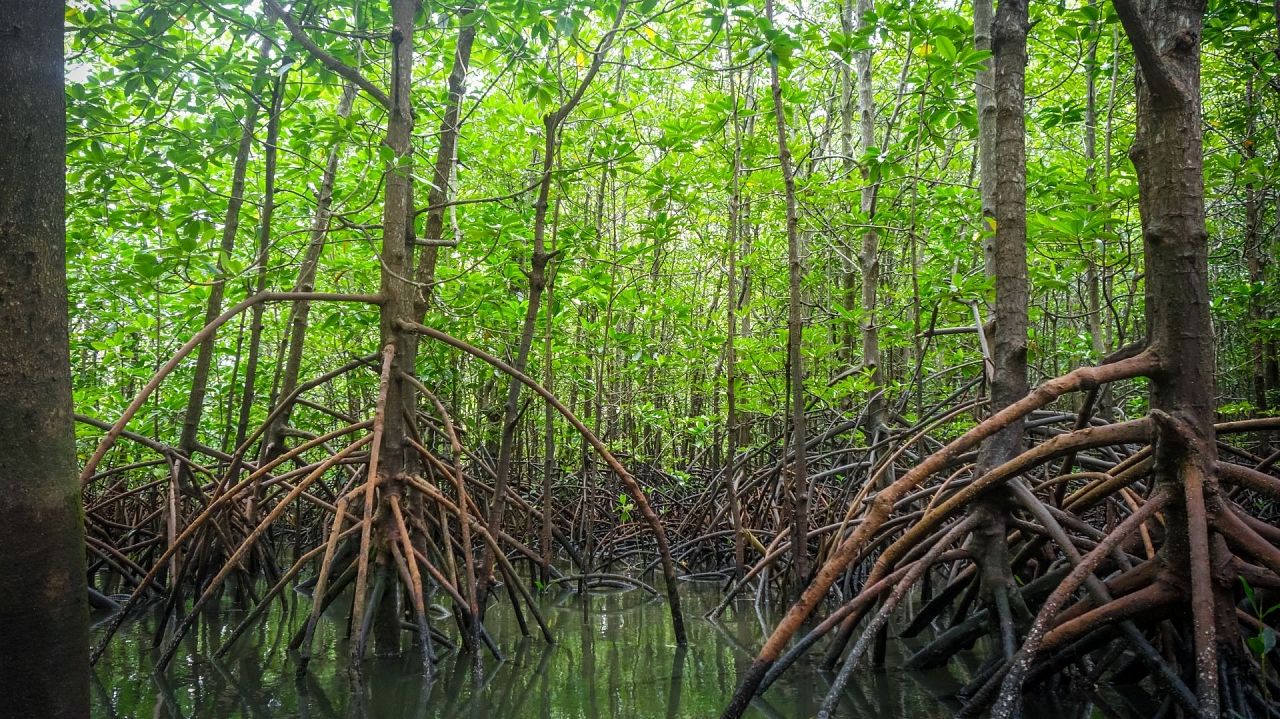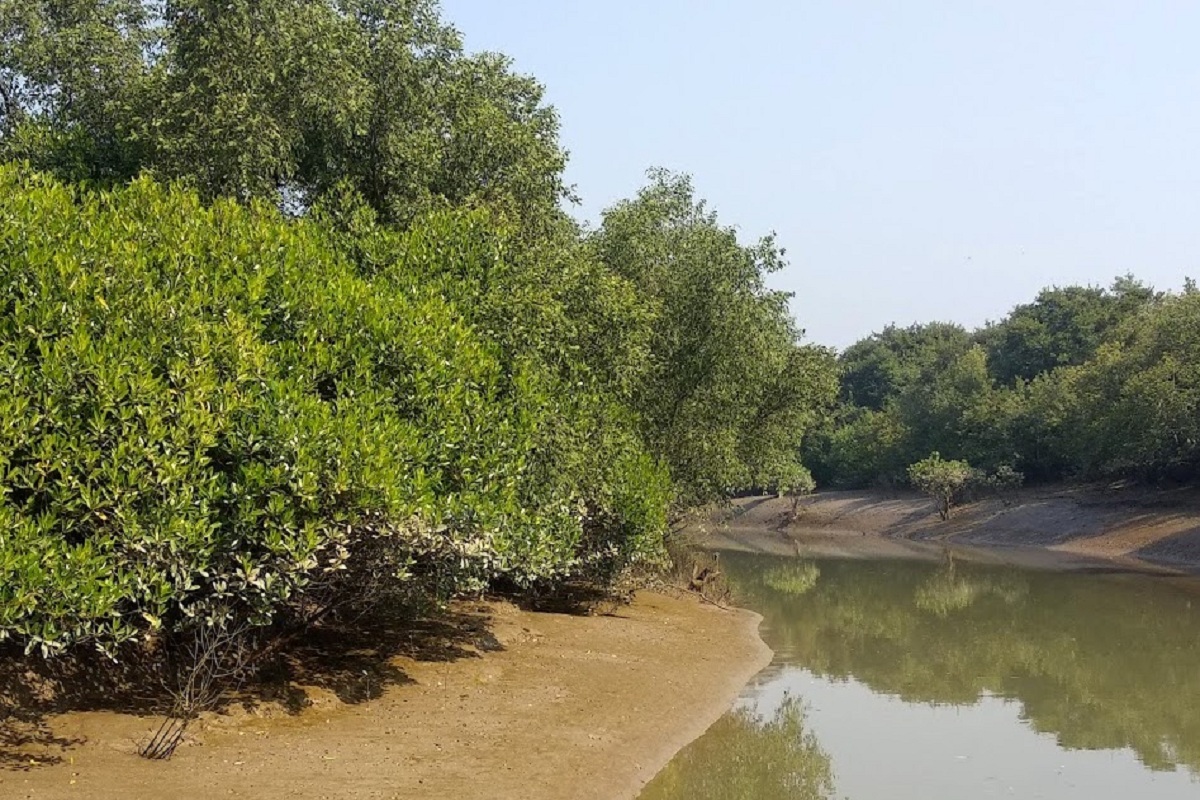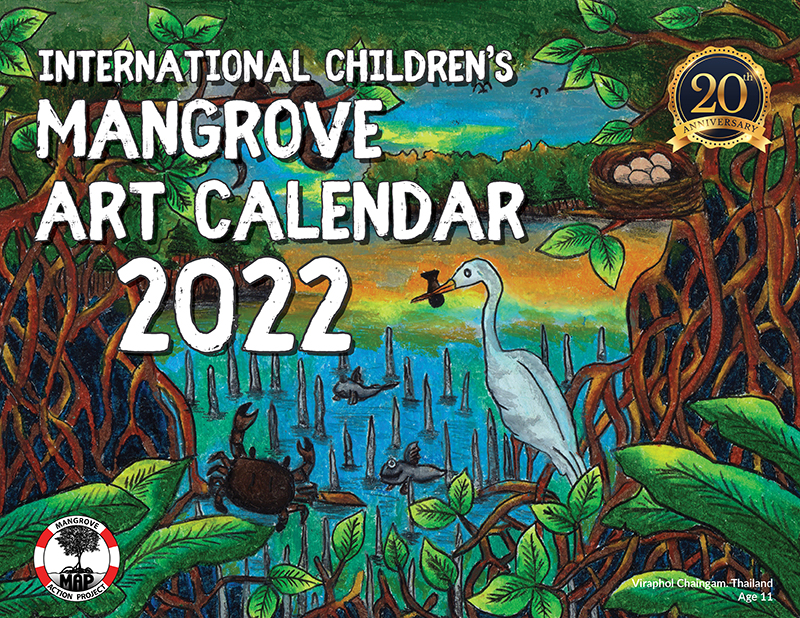MAP Website en Español haga clic aqui FEATURED STORY Children’s Mangrove Calendar Art Contest 2022

BAHAMAS – During the Bahamas CBEMR training that took place from April 8-14 in Freeport on Grand Bahama, Monica Gutierrez-Quarto collaborated with Waterkeepers and with the resident artist Marie Louis Hayward producing the Kids Art Mangrove workshop on April 13th. Two art projects were presented to the students: a Painting workshop about animals of the mangroves and a silk screen workshop producing prints of a mangrove tree. Before the hands-on art projects, the students received an educative presentation by a scientist from Waterkeepers about mangroves in Grand Bahamas. The students also had the opportunity to see the mangrove nursery at the Rand Center, where both the CBEMR training workshop and the children’s art workshop took place. Twenty students from ages 7 to 13 years old participated in this project. The event lasted 3 hours, and the kids had a great time producing their varied creations. In addition, there were youth volunteers from the Waterkeepers that assisted and helped in the activity. It was a successful opportunity to educate Bahaman youth about the mangrove ecosystem via an integrated art curriculum. The guidelines for Mangrove Childrens Art Contest are updated and are published in MAP website. Deadline for submissions to this year’s contest is August 1,2022. READ MORE
AFRICA
Stewards of the forest: the pioneering women’s collective harvesting the Gambia’s oysters

GAMBIA- In the cool air of an April dawn, Marie Sambou, an oyster harvester, carves through the brown water of the Gambia River’s Tanbi wetland in her long wooden canoe. The size of Manhattan, Tanbi teems with life. The mangroves provide an important habitat for many birds and fish, which nest, breed and spawn in the protective, nutrient-rich environment. Snow-white egrets stalk schools of needle-like fish nipping through the shallows as curlews and hornbills whirl overhead, and higher still, vultures turn in lazy circles. For the next six hours or so, while the tide remains low enough to work, Sambou will paddle along the forests on the riverbank, knocking hard, rock-like west African mangrove oysters (Crassostrea tulipa) from the exposed mangrove roots. It is tedious, physical work – and painful. Sambou has only thin gloves and socks for protection; her hands and feet are scarred from the razor-edged oyster shells. READ MORE
Growing African mangrove forests aim to combat climate woes

SENEGAL – In a bid to protect coastal communities from climate change and encourage investment, African nations are increasingly turning to mangrove restoration projects, with Mozambique becoming the latest addition to the growing list of countries with large scale mangrove initiatives. Mozambique follows efforts across the continent — including in Kenya, Madagascar, Gambia and Senegal — and is touted as the world’s largest coastal or marine ecosystem carbon storage project. Known as blue carbon, carbon captured by these ecosystems can sequester, or remove, carbon dioxide from the atmosphere at a faster rate than forests, despite being smaller in size. Mozambique’s mangrove restoration project — announced in February alongside its UAE-based partner Blue Forest — hopes to turn 185,000 hectares (457,100 acres) in the central Zambezia and southern Sofala provinces into a forest which could capture up to 500,000 tons of carbon dioxide, according to project leaders. READ MORE
A mangrove revolution: How Egypt is prioritising climate projects

EGYPT – Al-Quweh was one of six Red Sea locations where a two-year government project aimed to rehabilitate mangrove plantations. Launched in April 2020, the project was set to recover a total area of 210 hectares of mangrove forests. It was to serve as a line of defence, to slow down the effects of climate change – the most pressing of which is rising sea levels. The rate of rise in Red Sea levels has nearly doubled in recent years, according to a 2021 study. While this project failed to kickstart in some locations, it was a hit in others. The deterioration of Egypt’s mangroves is the result of the mushrooming construction of tourist villages nearby mangrove forests. This is as well as recurring oil leaks from shipping lines and oil excavations, and locals’ continuous overgrazing of their herds of camels, goats and sheep, explains Dr. Sayed Bakr, director of the Western Desert Reserve. So the ongoing project – with a budget of 4 million Egyptian pounds (€200,054) and funded by the government’s Academy of Scientific Research and Technology – should “increase mangroves’ spread to 60 acres in each location”. READ MORE
AMERICAS
A closer look at the Fruit Farm Creek Restoration Project

FLORIDA – Is restoration enough? There are around 110,00 acres of land throughout the state of Florida. About 20-30 thousand of those acres are mangroves. Mangroves are a state-regulated species with many benefits to wildlife and the environment. There are three types of mangrove species: Red, White, and Black. These species are protected by the City of Naples at the Rookery Bay National Estuarine Research Reserve. The most abundant of the three species are the Red Mangroves. “Restoration is used to preserve what is left of the mangroves,” Laakkonen said. According to Laakkonen, the restoration project was put into place to preserve what is left of the mangroves, more generally the red mangroves because no matter where they are planted the natural production of seeds will help to expand the mangroves and enlarge the restoration projects. READ MORE
This island nation will be one of the first to sell ocean-based credits

BAHAMAS – Seagrass beds and mangrove trees in the Bahamas’ crystal-clear waters may soon be drafted into the fight against climate change. The Caribbean country plans to offer “blue carbon” credits this year as a way for companies internationally to offset their emissions, the country’s prime minister announced last week. The island nation will be one of the first to sell ocean-based credits, and hopes to use the proceeds to invest in climate resilience projects. Coastal ecosystems, such as seagrass meadows and mangrove forests, are some of the world’s most powerful carbon sinks, storing three to five times more carbon per hectare than tropical forests. They do so mainly by storing dead and decaying plant matter in the ocean floor, as well as sequestering carbon by pulling it straight from the air and water. Last year, an international team of researchers found that these marine habitats already store up to 30 billion tons of carbon — nearly as much as the world emitted in 2021 from fossil fuel burning alone. READ MORE
Builders hurt protected areas in climate-weary Puerto Rico

PUERTO RICO – Homes of concrete block complete with fences, pools and even a dock have been illegally built inside the Jobos Bay National Estuarine Research Reserve. The reserve has protected nearly 2,900 acres of mangrove forest surrounded by waters in varying shades of turquoise. It is home to the critically endangered hawksbill sea turtle and the vulnerable West Indian manatee, among other species. Activists and some public employees say they are frustrated and feel alone in their fight as they accuse Puerto Rico’s Department of Natural Resources and other agencies of not doing their jobs. When a legislator during one public hearing asked the director of the Jobos Bay reserve who exactly had failed in their duties by allowing the illegal construction, she answered, “The entire system.” READ MORE
Protecting coastal vegetation means weighing development against the environment

USA – In September 2021, a team from the Rookery Bay National Estuarine Research Reserve broke ground on one of the largest mangrove restoration projects in the state of Florida. The Fruit Farm Creek Mangrove Restoration Project will install three 54-inch-diameter culverts beneath San Marco Road, connecting the two sections of wetlands and returning sheet flow to the mangrove forest. The project is budgeted to cost $1.4 million, a price many insist is worth it. Mangroves are essential to Southwest Florida—not just for the health of the ecology, but as a barrier to storms. Biologists, marine engineers and developers all know this. The problems arise at the intersection of these competing interests. Even as we create jobs for builders, contractors and tradesmen, even as we add more property value to the tax roll, even as we attract visitors and new residents who funnel millions of dollars into the state’s coffers, we risk sacrificing one of the most important parts of the Gulfshore. READ MORE
ASIA
Global investors exposed to mangrove deforestation linked Southeast Asian shrimp industry

THAILAND – Shrimp producers in Southeast Asia – and the investors backing them – face financial risks from mangrove deforestation, according to a recent report from Planet Tracker. Mangrove forests benefit coastal ecosystems in a multitude of ways, including preventing coastal erosion, protecting inland areas from storm surges, filtering water, and providing nursery habitat for many fish species. Though they only account for 1 percent of carbon sequestration from forests, they make up 14 percent of carbon sequestration from the ocean. But mangroves are disappearing at an alarming rate. Globally, the rate of destruction of mangrove forests compared to their total area is five times higher than rainforests, according to Planet Tracker. In Southeast Asia, shrimp farming is the cause of 30 percent of mangrove deforestation and coastal land use change. That deforestation threatens the ecological sustainability of the shrimp industry, and its financial viability. Investors around the world could be at risk as rules come into force preventing the importation of products linked to past and future deforestation, according to Planet Tracker Director of Research Matthew McLuckie. Neither shrimp companies nor the top 20 institutional investors report mangrove deforestation or emissions from farmed shrimp. Accurate profit margins can’t be assessed because of this lack of disclosure, meaning that investors can’t be confident of their risk exposure. READ MORE
Odisha’s logs country’s highest growth in mangrove forest: Patnaik

INDIA = Odisha has recorded the highest increase in mangrove forest, otherwise described as coastal woodland, in the country in the last three years, Chief Minister Naveen Patnaik said on Thursday. Inaugurating a conference of Divisional Forest officers, Chief Minister Naveen Patnaik said the State had added the highest growth in the mangrove forest in the country while adding that in spite of the difficult situation due to the pandemic, Odisha’s forest cover has improved in the last two years as per India State of Forests Report- 2021. Patnaik directed the forest officials to prepare a concrete roadmap for improving the health of State’s forests and enhancing the living standards of our forest fringe villagers. “We have added the highest number of mangrove forests in the country and third highest in total increase of forest cover between 2019 and 2021. This has been possible due to constant support of our people, the VSS members and tireless effort of forest staff in the field”, he said while calling upon the officials to work towards continuing this trend in the years to come. “Afforestation is a key component for providing employment to people in forest fringe villages. He advised the officials to rope in Women Self Help Groups for raising seedlings for the forest department”, he said. READ M ORE
Like this newsletter?
Pease consider donating to MAP to keep it going.
Giving could never be easier  *Articles in this newsletter may mention practices being used and/or show exagerated results being claimed without proof. Stories are presented here in effort to show mangrove related activity around the world and do not necessarily reflect Mangrove Action Project’s views or mangrove restoration best-practices. | ACTION ALERTS
Stop this total madness Stop the biggest heated oil pipeline in the world — right through the heart of Africa!
CLICK HERE Strengthen 60 Women Farmers in El Salvador
DONATE HERE Stop construction work on a private port In Defense of the Quilombo Boca Do Rio TAKE ACTION! Tell Sumitomo to stop building polluting coal power in Bangladesh! TAKE ACTION!
Like this newsletter? Pease consider donating to MAP to keep it going. Giving could never be easier 
MAP Website en Español
haga clic aqui ORDER YOUR 2022 MAP CHILDREN’S ART CALENDER HERE
 13 Year old Linda Li “Mangrove Adventure” from Kid Dream Art School

WATCH NOW 
Restoring The Natural Mangrove Forest
Watch movie

Community Based Ecological Mangrove Restoration in Rufiji Delta VIEW VIDEO
Video: Mangroves for the Future
View Here WANT TO GET INVOLVED?
Follow and Join MAP!    
Like this newsletter? Pease consider donating to MAP to keep it going. Giving could never be easier 

Interested in connecting or working with MAP? Check out our opportunities here 
MANGROVE ISSUES Want to learn more about mangroves?
Our short presentation will give you a better understanding of the issues we are working to solve. WATCH PRESENTATION What is CBEMR? Download MAP’s 2 page CBEMR Information Sheet containing links to all MAP’s CBEMR resources – CLICK HERE View MAP’s uploaded Videos at
MAP Video Gallery Question Your Shrimp Consumer/Markets Campaign!
WATCH VIDEO Mangroves: Guidebook to Malaysia – Click Here SHARE MAP’S VISION
CLICK HERE to watch short introductory video. Together we can work “at the roots of the sea”. Our short documentary, Reducing the Risk of Disaster through Nature-Based Solutions : Mangroves 
NASA Study Maps the Roots of Global Mangrove Loss

Marvellous Mangroves Curriculum The Marvellous Mangroves Curriculum begins with a simple philosophy – getting future generations to not only learn about, but understand the importance of mangrove forests. VISIT 
The award-winning Marvellous Mangroves (MM) curriculum educates children on the importance of mangroves and their ecological functions, teaching them about modern challenges and mechanisms for sustainability. VIEW VIDEO Marvellous Mangroves Curriculum in Bangladesh – WATCH VIDEO
MARVELLOUS MANGROVES IN BRAZIL
En Portuges 
Marvellous Mangroves – A Curriculum-Based Teachers Guide.
Like this newsletter? Pease consider donating to MAP to keep it going. Giving could never be easier 
“Question Your Shrimp” Campaign Question Your Shrimp – is it really sustainable? Sign the Petition
Note to Our Readers: We strive to keep active links in our newsletter. However, due to circumstances beyond our control, occasionally links to stories may become broken. If you find a link to a story is not functioning, please cut and paste the headline into your browser search bar. In most cases you should be able to locate the original story.
Not yet a MAP News subscriber?
Click here to subscribe.  *Articles in this newsletter may mention practices being used and/or show exagerated results being claimed without proof. Stories are presented here in effort to show mangrove related activity around the world and do not necessarily reflect Mangrove Action Project’s views or mangrove restoration best-practices. *Articles in this newsletter may mention practices being used and/or show exagerated results being claimed without proof. Stories are presented here in effort to show mangrove related activity around the world and do not necessarily reflect Mangrove Action Project’s views or mangrove restoration best-practices.
|


























